Development Trend in Composition Optimization, Microstructure Manipulation, and Strengthening Methods of Die Steels under Lightweight and Integrated Die Casting
Abstract
1. Introduction
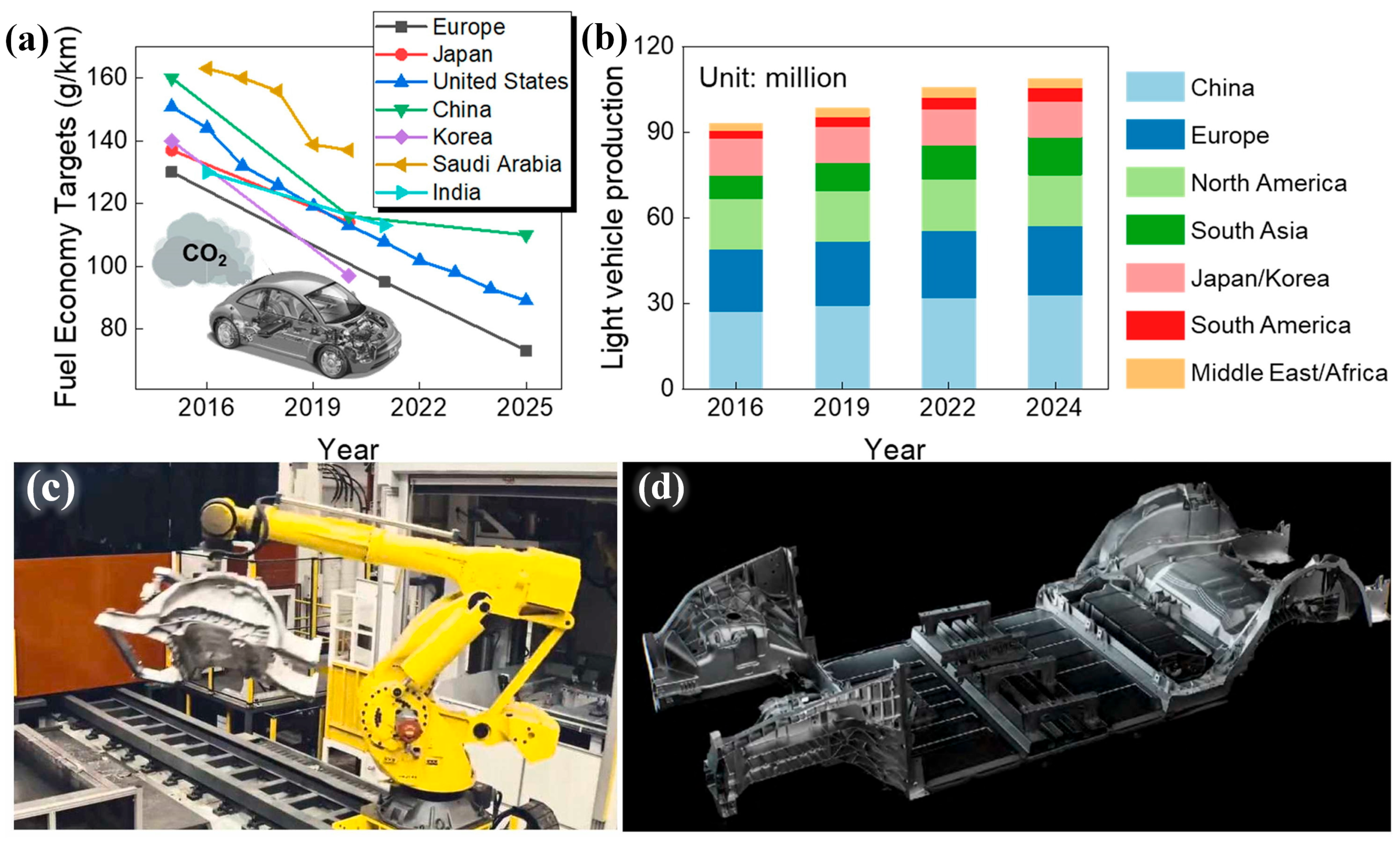
2. Development in Composition Optimization of Die Steel for Integrated Die Casting
2.1. Traditional Hot-Working Die Steels
2.2. New Hot-Working Die Steels

3. Development in Microstructure Manipulation and Strengthening Methods of Die Steel for Integrated Die Casting
3.1. Melt Purification and Impurity Removal
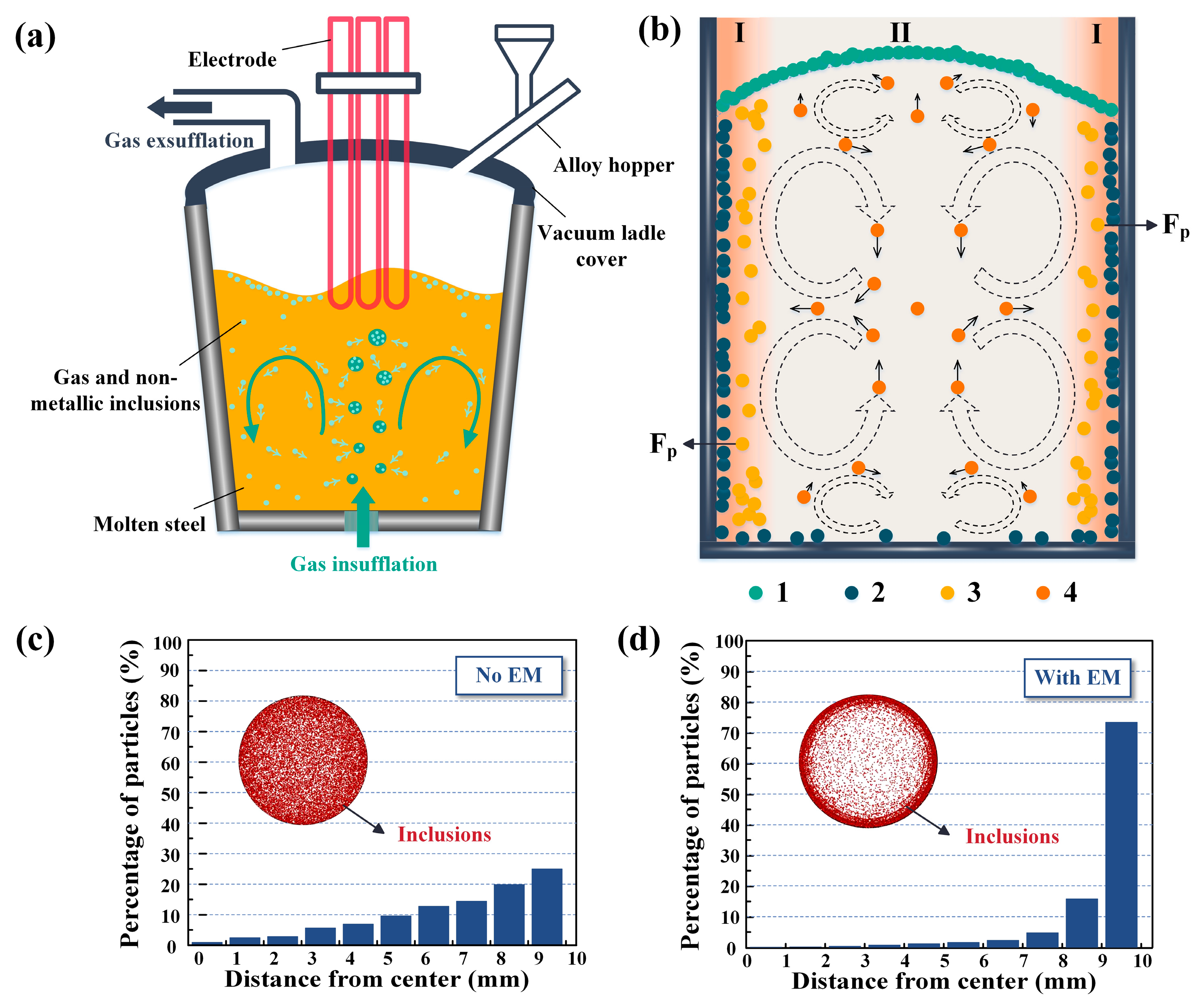
3.2. Optimal Treatment of Microalloying
| Alloy Element | Content Range | Main Functions and Features | Ref. |
|---|---|---|---|
| C | 0.3–0.6% | Increases the strength, hardness, and wear resistance of steel due to the formation of solid solutions and carbides | [66,69] |
| Cr | 2.0–12.0% | Ubiquitous in die steel, improves wear resistance, corrosion resistance, toughness, hardenability, etc. | [40] |
| Mo | 1.0–3.0% | The main alloying element for secondary hardening can also effectively improve the thermal strength of steel | [68,69,70] |
| V | 0.05–1.2% | Refining grain and microstructure, improving tempering stability, and secondary hardening effect | [71,72] |
| Mn | 0.15–1.0% | Improve the strength, hardness, and hardenability of steel without much damage to the plasticity and toughness | [73] |
| Si | ≥0.4% | Replacing ferrite and solid solution strengthens effectively and improves the strength, hardness, and tempering stability of steel | [27] |
3.3. Secondary Refinement and Purification by Electroslag Remelting
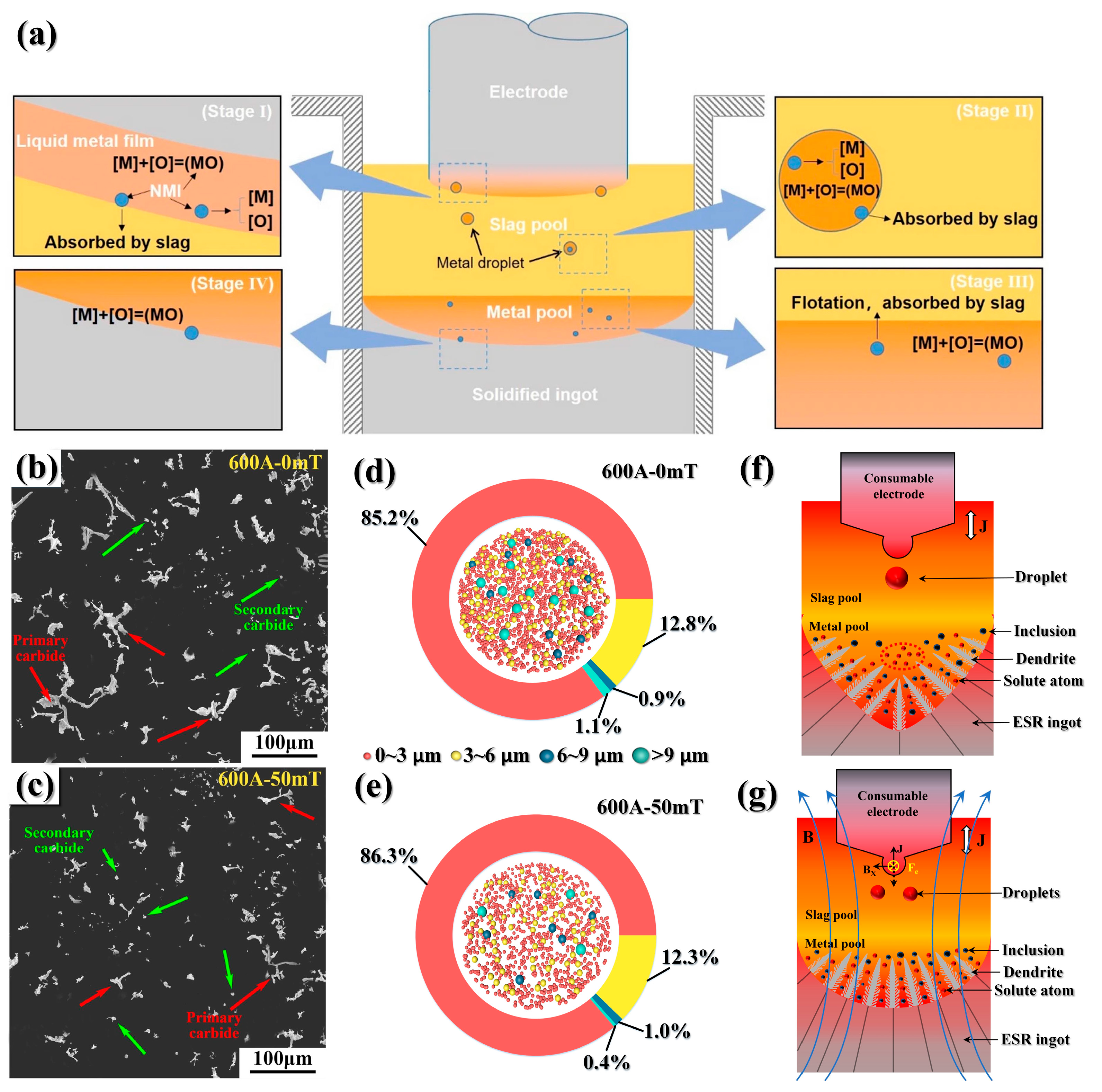
3.4. Refined and Densified Microstructure via a Large Forging Ratio
3.5. Optimization of Heat Treatment
4. Nanoparticle Reinforcements
5. Summary and Prospects
Author Contributions
Funding
Institutional Review Board Statement
Informed Consent Statement
Data Availability Statement
Conflicts of Interest
References
- Zhao, F.; Liu, X.; Zhang, H.; Liu, Z. Automobile Industry under China’s Carbon Peaking and Carbon Neutrality Goals: Challenges, Opportunities, and Coping Strategies. J. Adv. Transp. 2022, 2022, 5834707. [Google Scholar] [CrossRef]
- Yuan, X.; Liu, X.; Zuo, J. The development of new energy vehicles for a sustainable future: A review. Renew. Sust. Energ. Rev. 2015, 42, 298–305. [Google Scholar] [CrossRef]
- Zhang, W.; Xu, J. Advanced lightweight materials for Automobiles: A review. Mater. Des. 2022, 221, 110994. [Google Scholar] [CrossRef]
- Hong, L.; Xin, L. The Present Situation and The Development Trend of New Materials Used in Automobile Lightweight. In Proceedings of the International Conference on Information Engineering for Mechanics and Materials (ICIMM), Hangzhou, China, 19–22 May 2012. [Google Scholar]
- Li, M.H.; Li, Z.R.; Jiang, L. Preliminary Study of Automobile Lightweight Technology. In Proceedings of the 4th International Conference on Mechanical Materials and Manufacturing Engineering (MMME), Wuhan, China, 15–16 October 2016. [Google Scholar]
- Cischino, E.; Di Paolo, F.; Mangino, E.; Pullini, D.; Elizetxea, C.; Maestro, C.; Alcalde, E.; Christiansen, J.D. An advanced technological lightweighted solution for a Body in White. In Proceedings of the 6th Transport Research Arena (TRA), Warsaw, Poland, 18–21 April 2016. [Google Scholar]
- Dama, K.K.; Babu, V.S.; Rao, R.N. State of the Art on Automotive Lightweight Body-in-White Design. In Proceedings of the International Conference on Smart Engineering Materials (ICSEM), Bangalore, India, 20–22 October 2016. [Google Scholar]
- Chen, L.-Y.; Liang, S.-X.; Liu, Y.; Zhang, L.-C. Additive manufacturing of metallic lattice structures: Unconstrained design, accurate fabrication, fascinated performances, and challenges. Mater. Sci. Eng. R Rep. 2021, 146, 100648. [Google Scholar] [CrossRef]
- Sun, W.L.; Chen, X.K.; Wang, L. Analysis of Energy Saving and Emission Reduction of Vehicles Using Light Weight Materials. In Proceedings of the Applied Energy Symposium and Summit—Low Carbon Cities and Urban Energy Systems (CUE), Fuzhou, China, 15–17 November 2015. [Google Scholar]
- Liu, D.F.; Tao, J. Application of Automobile Lightweight Alloys and the Development of its Die-Casting Technology. International Conference on Advanced Design and Manufacturing Engineering, Guangzhou, China, 16–18 September 2011. [Google Scholar]
- Zhao, J.Y.; Li, L.; Fan, Q.C.; Zhu, X.Y. Analysis on the Development of Light-Weight Automobile Body. In Proceedings of the 19th COTA International Conference of Transportation Professionals (CICTP)—Transportation in China 2025, Nanjing, China, 6–8 July 2019. [Google Scholar]
- Luo, A.A.; Sachdev, A.K.; Apelian, D. Alloy development and process innovations for light metals casting. J. Mater. Process. Technol. 2022, 306, 117606. [Google Scholar] [CrossRef]
- Sivanur, K.; Umananda, K.V.; Pai, D. Advanced Materials Used in Automotive Industry-A Review. In Proceedings of the 3rd International Conference on Advancements in Aeromechanical Materials for Manufacturing (ICAAMM), Hyderabad, India, 24–25 July 2020. [Google Scholar]
- Guo, R.C.; Wu, N.; Zhang, G.R. New Materials for Auto-body Lightweight Applications. In Proceedings of the 2nd International Conference on Material and Manufacturing Technology (ICMMT 2011), Xiamen, China, 8–11 July 2011. [Google Scholar]
- Kulekci, M.K. Magnesium and its alloys applications in automotive industry. Int. J. Adv. Manuf. Technol. 2008, 39, 851–865. [Google Scholar] [CrossRef]
- Kumar, D.S.; Sasanka, C.T.; Ravindra, K.; Suman, K.N.S. Magnesium and Its Alloys in Automotive Applications—A Review. J. Mater. Sci. Technol. 2015, 4, 12–30. [Google Scholar] [CrossRef]
- Hu, H.; Yu, A.; Li, N.; Allison, J.E. Potential Magnesium Alloys for High Temperature Die Cast Automotive Applications: A Review. Mater. Manuf. Process. 2003, 18, 687–717. [Google Scholar] [CrossRef]
- Viswanadhapalli, B.; Bupesh Raja, V.K. Application of Magnesium Alloys in Automotive Industry-A Review. In Proceedings of the COMET 2019: Emerging Trends in Computing and Expert Technology, Chennai, India, 22–23 March 2019; Volume 35, pp. 519–531. [Google Scholar]
- Wang, G.G.; Weiler, J.P. Recent developments in high-pressure die-cast magnesium alloys for automotive and future applications. J. Magnes. Alloy. 2023, 11, 78–87. [Google Scholar] [CrossRef]
- Chang, F.; Li, C.-D.; Yang, H.-Y.; Qiu, F.; Shu, S.-L.; Chen, L.-Y.; Jiang, Q.-C. Hot-work die steel with superior mechanical properties at room and high temperatures prepared via a combined approach of composition design and nanoparticle modification. J. Mater. Res. Technol. 2023, 25, 1748–1760. [Google Scholar] [CrossRef]
- Chang, F.; Shu, S.-L.; Li, C.-D.; Qiu, F.; Jiang, Q.-C. Effect of Nano-TiC Ceramic Particles on Microstructures and Properties of High-Cr Steel under Different Heat-Treatment Conditions. Adv. Eng. Mater. 2023, 2300631. [Google Scholar] [CrossRef]
- Wang, H.; Li, H.; Feng, H.; Jiao, W.; Zhu, H.; Zhang, S.; Jiang, Z. A novel high nitrogen hot-work die steel 3Cr5Mo2SiVN achieving excellent hardness-strength-toughness balance. Mater. Charact. 2023, 203, 113–154. [Google Scholar] [CrossRef]
- Wang, S.-Q.; Chen, K.-M.; Cui, X.-H.; Jiang, Q.-C.; Hong, B. Effect of Alloying Elements on Thermal Wear of Cast Hot-Forging Die Steels. J. Iron Steel Res. Int. 2006, 13, 53–59. [Google Scholar] [CrossRef]
- Xie, H.-J.; Wu, X.-C.; Min, Y.-a. Influence of Chemical Composition on Phase Transformation Temperature and Thermal Expansion Coefficient of Hot Work Die Steel. J. Iron Steel Res. Int. 2008, 15, 56–61. [Google Scholar] [CrossRef]
- Zhao, F.; He, G.-N.; Liu, Y.-Z.; Zhang, Z.-H.; Xie, J.-X. Effect of titanium microalloying on microstructure and mechanical properties of vanadium microalloyed steels for hot forging. J. Iron Steel Res. Int. 2022, 29, 295–306. [Google Scholar] [CrossRef]
- Wang, L.; Song, B.; Yang, Z.B.; Cui, X.K.; Liu, Z.; Cheng, W.S.; Mao, J.H. Effects of Mg and La on the evolution of inclusions and microstructure in Ca-Ti treated steel. Int. J. Miner. Metall. Mater. 2021, 28, 1940–1948. [Google Scholar] [CrossRef]
- Huang, S.; Lei, T.; Chi, H.; Ma, D. Application of Si in Tool and Die Steel, International Conference on Insulating Materials. In Proceedings of the Material Application and Electrical Engineering (MAEE 2013), Changsha, China, 16–17 March 2013. [Google Scholar]
- Jiang, Q.C.; Sui, H.L.; Guan, Q.F. Thermal fatigue behavior of new type high-Cr cast hot work die steel. ISIJ Int. 2004, 44, 1103–1107. [Google Scholar] [CrossRef]
- Sun, L.-Y.; Liu, X.; Xu, X.; Lei, S.-W.; Li, H.-G.; Zhai, Q.-j. Review on niobium application in microalloyed steel. J. Iron Steel Res. Int. 2022, 9, 1513–1525. [Google Scholar] [CrossRef]
- Gronostajski, Z.; Pater, Z.; Madej, L.; Gontarz, A.; Lisiecki, L.; Lukaszek-Solek, A.; Luksza, J.; Mroz, S.; Muskalski, Z.; Muzykiewicz, W.; et al. Recent development trends in metal forming. Arch. Civ. Mech. Eng. 2019, 19, 898–941. [Google Scholar] [CrossRef]
- Singh, G. A review on effect of heat treatment on the properties of mild steel. In Proceedings of the International Conference on Newer Trends and Innovations in Mechanical Engineering (ICONTIME)—Materials Science, Tiruchirappalli, India, 27–28 March 2020. [Google Scholar]
- Yan, G.; Huang, X.; Wang, Y.; Qin, X.; Yang, M.; Chu, Z.; Jin, K. Effects of heat treatment on mechanical properties of h13 steel. Met. Sci. Heat Treat. 2010, 52, 393–395. [Google Scholar]
- High Performance Hot Work Die Steel-DH31-EX. Available online: https://www.daido.co.jp/cn/common/pdf/pages/products/tool/dh31_ex.pdf (accessed on 25 May 2023).
- YSS Die Steels for Die Casting DAC Series. Available online: http://www.hitachi.co.in/pdf/resources/high-function-materials-and-components/advanced-materials-and-components/dac-b.pdf (accessed on 25 May 2023).
- High Proformance Tool Steel For Diecasting in Pursuit of the Supermacy of Dies-KDAMAX. Available online: http://www.koshuha.co.jp/products/pdf/tool_kdamax.pdf (accessed on 25 May 2023).
- Balasko, T.; Burja, J.; Medved, J. High-temperature oxidation of four hot-work tool steels. Mater. Tehnol. 2018, 52, 775–780. [Google Scholar] [CrossRef]
- Xie, Y.; Cheng, X.; Wei, J.; Luo, R. Characterization of Carbide Precipitation during Tempering for Quenched Dievar Steel. Materials 2022, 15, 6448. [Google Scholar] [CrossRef] [PubMed]
- Uddeholm. Available online: https://www.uddeholm.com/app/uploads/sites/54/2018/02/Tech-Uddeholm-Dievar-EN-1.pdf (accessed on 25 May 2023).
- Meurisse, E.; Chruff, I. CS1-The new hot-work tool steel for die casting dies with the highest surface requirements. Metall. Ital. 2021, 113, 43–48. [Google Scholar]
- Jiang, Q.C.; Zhao, X.M.; Qiu, F.; Ma, T.N.; Zhao, Q.L. The Relationship Between Oxidation and Thermal Fatigue of Martensitic Hot-Work Die Steels. Acta Metall. Sin.-Engl. 2018, 31, 692–698. [Google Scholar] [CrossRef]
- Yamasaki, S.; Mitsuhara, M.; Nakashima, H. Development of High-Chromium Ferritic Heat-Resistant Steels with High Nitrogen Content. ISIJ Int. 2018, 58, 1146–1154. [Google Scholar] [CrossRef]
- Jang, Q.-C. New high performance hot work die steel. China Foundry Week, 24 October; 2009.
- Abiko, K.; Takaki, S. Ultra-purification of iron by ultra-high vacuum melting. Vacuum 1999, 53, 93–96. [Google Scholar] [CrossRef]
- Storti, E.; Jankovsky, O.; Sedmidubsky, D.; Dudczig, S.; Aneziris, C.G. Filter Coatings Based on Combination of Nanomaterials for Steel Melt Filtration. Adv. Eng. Mater. 2020, 22, 1900457. [Google Scholar] [CrossRef]
- Shao, P.; Liu, S.X.; Miao, X.C. CFD-PBM simulation of bubble coalescence and breakup in top blown-rotary agitated reactor. J. Iron Steel Res. Int. 2022, 29, 223–236. [Google Scholar] [CrossRef]
- Qin, X.; Cheng, C.; Li, Y.; Zhang, C.; Zhang, J.; Jin, Y. A Simulation Study on the Flow Behavior of Liquid Steel in Tundish with Annular Argon Blowing in the Upper Nozzle. Metals 2019, 9, 225. [Google Scholar] [CrossRef]
- Qin, X.; Cheng, C.; Li, Y.; Wu, W.; Jin, Y. Bubble behavior under a novel metallurgy process coupling an annular gas curtain with swirling flow at tundish upper nozzle. J. Mater. Res. Technol. 2022, 21, 3195–3206. [Google Scholar] [CrossRef]
- Wang, K.; Liu, Y.; Sano, M.; Zhang, T. Bubble behavior in cylindrical and square vessels under centric mechanical stirring. J. Iron Steel Res. Int. 2021, 28, 1243–1250. [Google Scholar] [CrossRef]
- Zhu, H.; Zhao, J.; Li, J.; Hu, Q.; Peng, C. Evolution of nonmetallic inclusions in pipeline steel during LF and VD refining process. High Temp. Mater. Process. 2020, 39, 424–432. [Google Scholar] [CrossRef]
- Li, Y.; Jiang, Z.; Yin, S.; Zhuang, Y.; Li, M. Formation and Control of Inclusions during Steelmaking Process. In Proceedings of the 1st International Conference on Mechanical Engineering, Phuket, Thailand, 3–4 April 2011. [Google Scholar]
- Gubenko, S.I. Effect of “nonmetallic inclusion-matrix” phase boundaries on the cohesive resistance of steel. Met. Sci. Heat Treat. 2006, 48, 13–18. [Google Scholar] [CrossRef]
- Park, I.-J.; Lee, S.-M.; Kang, M.; Lee, S.; Lee, Y.-K. Pitting corrosion behavior in advanced high strength steels. J. Alloys Compd. 2015, 619, 205–210. [Google Scholar] [CrossRef]
- Chen, L.; Li, J.; Zhang, Y.; Lu, W.; Zhang, L.-C.; Wang, L.; Zhang, D. Effect of low-temperature pre-deformation on precipitation behavior and microstructure of a Zr-Sn-Nb-Fe-Cu-O alloy during fabrication. J. Nucl. Sci. Technol. 2016, 53, 496–507. [Google Scholar] [CrossRef]
- Aneziris, C.G.; Dudczig, S.; Emmel, M.; Berek, H.; Schmidt, G.; Hubalkova, J. Reactive Filters for Steel Melt Filtration. Adv. Eng. Mater. 2013, 15, 46–59. [Google Scholar] [CrossRef]
- Makarov, S.; Ludwig, R.; Apelian, D. Electromagnetic separation techniques in metal casting. I. Conventional methods. IEEE Trans. Magn. 2000, 36, 2015–2021. [Google Scholar] [CrossRef]
- Zhang, L.F.; Wang, S.Q.; Dong, A.P.; Gao, J.W.; Damoah, L.N.W. Application of Electromagnetic (EM) Separation Technology to Metal Refining Processes: A Review. Metall. Mater. Trans. B 2014, 45, 2153–2185. [Google Scholar] [CrossRef]
- Wang, D.; Li, Z.Y.; Zhu, Y.Q.; He, L.J. Research on purifying emulsion using electromagnetic technique and its control system. Ind. Lubr. Tribol. 2001, 53, 155–160. [Google Scholar] [CrossRef]
- Wang, S.Q.; Zhang, L.F.; Tian, Y.; Li, Y.L.; Ling, H.T. Separation of Non-metallic Inclusions from Molten Steel Using High Frequency Electromagnetic Fields. Metall. Mater. Trans. B 2014, 45, 1915–1935. [Google Scholar] [CrossRef]
- Cui, X.H.; Shan, J.; Yang, Z.R.; Wei, M.X.; Wang, S.Q.; Dong, C. Alloying design for high wear-resistant cast hot-forging die steels. J. Iron Steel Res. Int. 2008, 15, 67–72. [Google Scholar] [CrossRef]
- Wang, S.; Wang, F.; Chen, K.M.; Cui, X. A newly-developed high wear resistant cast hot-forging die steel. ISIJ Int. 2007, 47, 1335–1340. [Google Scholar] [CrossRef]
- Kruglyakov, A.A. Effect of Alloying Elements on the Hardening of Die Steels in the Austenitic State during High-Temperature Plastic Deformation. Russ. Metall. 2019, 2019, 1096–1101. [Google Scholar] [CrossRef]
- Gong, W.; Wang, C.; Wang, P.-F.; Jiang, Z.-H.; Wang, R.; Li, H.-b. Effect of La on inclusions and fracture toughness of low-alloy ultra-high-strength 40CrNi2Si2MoVA steel. J. Iron Steel Res. Int. 2021, 28, 1408–1416. [Google Scholar] [CrossRef]
- Ji, F.; Xu, R.; Gao, Y.-L.; Tian, Q.-C.; Wang, L.; Xiao, Z.-X.; Yin, F.-X. Effect of Ti and rare earth on microsegregation and large-sized precipitates of H13 steel. J. Iron Steel Res. Int. 2021, 28, 1591–1604. [Google Scholar] [CrossRef]
- Zhao, H.; Li, L.; Feng, Q. Isothermal oxidation behavior of Nb-bearing austenitic cast steels at 950 degrees C. Int. J. Miner. Metall. Mater. 2022, 29, 814–824. [Google Scholar] [CrossRef]
- An, J.; Cai, Z.; Zhu, M. Effect of titanium content on the refinement of coarse columnar austenite grains during the solidification of peritectic steel. Int. J. Miner. Metall. Mater. 2022, 29, 2172–2180. [Google Scholar] [CrossRef]
- Zhang, Q.Y.; Wang, S.Q.; Wang, L. Comparative study on wear of hot-working die steels. In Proceedings of the International Conference on Process Equipment, Mechatronics Engineering and Material Science, Wuhan, China, 15–16 June 2013. [Google Scholar]
- Saucedo-Munoz, M.L. Precipitation kinetics of carbides during cyclical and isothermal aging of 2.25Cr-1Mo steel and its effect on mechanical properties. J. Iron Steel Res. Int. 2021, 28, 1282–1290. [Google Scholar] [CrossRef]
- Du, N.; Liu, H.; Fu, P.; Liu, H.; Sun, C.; Cao, Y.; Li, D. Microstructural Stability and Softening Resistance of a Novel Hot-Work Die Steel. Crystals 2020, 10, 238. [Google Scholar] [CrossRef]
- Liu, Y.; Liu, Z.L.; Zhang, C.W. Calculation and analysis of valence electron structure of Mo2C and V4C3 in hot working die steel. J. Iron Steel Res. Int. 2006, 13, 50–56. [Google Scholar] [CrossRef]
- Wilson, R. Metallurgy and Heat Treatment of Tool Steels. J. Mater. Sci. 1976. [Google Scholar]
- Wang, S.F.; Liu, H.Y.; Zhou, P. Research on hot-work die steel used for extrusion wheel. In Proceedings of the 3rd International Conference on Manufacturing Science and Engineering (ICMSE 2012), Xiamen, China, 27–29 March 2012. [Google Scholar]
- Zhang, Z.; Zhang, J.; Yao, Z.; Xie, G.; Lian, Y.; Ma, M.; Zhao, C.; Huang, J. Design for Novel Hot-Work Die Steel by Thermodynamic Calculation and Microstructural Examination. Metals 2019, 9, 805. [Google Scholar] [CrossRef]
- Lee, Y.K.; Han, J. Current opinion in medium manganese steel. Mater. Sci. Technol. 2015, 31, 843–856. [Google Scholar] [CrossRef]
- Zhang, J.-W.; Cao, Y.-G.; Zhang, C.-G.; Li, Z.-D.; Wang, W.-X. Effect of Nb addition on microstructure and mechanical properties of 25CrNiMoV (DZ2) steel for high-speed railway axles. J. Iron Steel Res. Int. 2022, 29, 802–809. [Google Scholar] [CrossRef]
- Gu, J.; Li, J.; Chang, R.; Li, L. Comprehensive effect of nitrogen on Cr-Mo-V hot-working die steel with enhanced strength and toughness. Mater. Sci. Eng. A 2019, 766, 138386. [Google Scholar] [CrossRef]
- Gu, J.; Li, J.; Yanagimoto, J.; Li, W.; Li, L. Microstructural evolution and mechanical property changes of a new nitrogen-alloyed Cr-Mo-V hot-working die steel during tempering. Mater. Sci. Eng. A 2021, 804, 140721. [Google Scholar] [CrossRef]
- Li, J.-Y.; Chen, Y.-L.; Huo, J.-H. Mechanism of improvement on strength and toughness of H13 die steel by nitrogen. Mater. Sci. Eng. A 2015, 640, 16–23. [Google Scholar] [CrossRef]
- Qi, Y.; Li, J.; Shi, C. Characterization on Microstructure and Carbides in an Austenitic Hot-work Die Steel during ESR Solidification Process. ISIJ Int. 2018, 58, 2079–2087. [Google Scholar] [CrossRef]
- Ma, M.; Guo, H.; Wang, F.; Sun, X. Effect of Cooling Rate on the Solidification Microstructure and Characteristics of Primary Carbides in H13 Steel. ISIJ Int. 2019, 59, 848–857. [Google Scholar] [CrossRef]
- Shi, F.; Piao, N.; Wang, H.; Wang, J.; Zang, Q.; Guo, Y.; Chen, C.; Zhang, L. Investigation of microstructure and mechanical properties of ZK60 magnesium alloy achieved by extrusion-shearing process. J. Mater. Res. Technol. 2023, 25, 799–811. [Google Scholar] [CrossRef]
- Hernandez-Morales, B.; Mitchell, A. Review of mathematical models of fluid flow, heat transfer, and mass transfer in electroslag remelting process. Ironmak. Steelmak. 1999, 26, 423–438. [Google Scholar] [CrossRef]
- Weber, V.; Jardy, A.; Dussoubs, B.; Ablitzer, D.; Ryberon, S.; Schmitt, V.; Hans, S.; Poisson, H. A Comprehensive Model of the Electroslag Remelting Process: Description and Validation. Metall. Mater. Trans. B 2009, 40, 271–280. [Google Scholar] [CrossRef]
- Shi, C.B.; Chen, X.C.; Guo, H.J.; Zhu, Z.J.; Ren, H. Assessment of Oxygen Control and Its Effect on Inclusion Characteristics during Electroslag Remelting of Die Steel. Steel Res. Int. 2012, 83, 472–486. [Google Scholar] [CrossRef]
- Li, Q.; Xia, Z.-B.; Guo, Y.-F.; Shen, Z.; Zheng, T.-X.; Ding, B.; Zhong, Y.-B. Effect of axial static magnetic field on cleanliness and microstructure in magnetically controlled electroslag remelted bearing steel. J. Iron Steel Res. Int. 2021, 28, 1562–1573. [Google Scholar] [CrossRef]
- Zheng, D.-L.; Ma, G.-J.; Zhang, X.; Liu, M.-K.; Li, Z. Evolution of MnS and MgO center dot Al2O3 inclusions in AISI M35 steel during electroslag remelting. J. Iron Steel Res. Int. 2021, 28, 1605–1616. [Google Scholar] [CrossRef]
- Shi, C.B.; Wang, S.J.; Li, J.; Cho, J.W. Non-metallic inclusions in electroslag remelting: A review. J. Iron Steel Res. Int. 2021, 28, 1483–1503. [Google Scholar] [CrossRef]
- Qi, Y.-F.; Li, J.; Shi, C.-B.; Zhang, Y.; Zhu, Q.-T.; Wang, H. Effect of directional solidification of electroslag remelting on the microstructure and primary carbides in an austenitic hot-work die steel. J. Mater. Process. Technol. 2017, 249, 32–38. [Google Scholar] [CrossRef]
- Dong, Y.-W.; Jiang, Z.-H.; Cao, Y.-L.; Yu, A.; Hou, D. Effect of Slag on Inclusions During Electroslag Remelting Process of Die Steel. Metall. Mater. Trans. B 2014, 45, 1315–1324. [Google Scholar] [CrossRef]
- Ma, C.; Xia, Z.; Guo, Y.; Liu, W.; Zhao, X.; Li, Q.; Qi, W.; Zhong, Y. Carbides refinement and mechanical properties improvement of H13 die steel by magnetic-controlled electroslag remelting. J. Mater. Res. Technol. 2022, 19, 3272–3286. [Google Scholar] [CrossRef]
- Lorenzino, P.; Buffiere, J.-Y.; Verdu, C. 3D characterization of the propagation of small fatigue cracks in steels with different forging conditions. Int. J. Fatigue 2018, 115, 2–10. [Google Scholar] [CrossRef]
- Liu, X.; Xiao, L.; Wei, C.; Xu, X.; Luo, M.; Yan, W. Effect of multi-directional forging and annealing on abrasive wear behavior in a medium carbon low alloy steel. Tribol. Int. 2018, 119, 608–613. [Google Scholar] [CrossRef]
- Jiang, J.; Liu, Y.; Liu, C. Effect of forging ratio on the microstructure, mechanical properties and abrasive wear behavior of a new C-Cr-Mo-V martensitic steel. J. Mater. Res. Technol. 2022, 19, 4076–4091. [Google Scholar] [CrossRef]
- Dai, W.; Yao, Z.; Zhang, H.; Li, C.; Liu, Y.; Zhang, Y. Effect of forging ratio on tensile properties and fatigue performance of EA4T steel. J. Manuf. Process. 2022, 76, 291–303. [Google Scholar] [CrossRef]
- Pastor, A.; Valles, P.; Amurrio, I.; Medina, S.F. Heat treatment conditions to prevent failure in die cast X38CrMoV5 steel parts. Eng. Fail. Anal. 2015, 56, 520–529. [Google Scholar] [CrossRef][Green Version]
- Ma, T.-W.; Hao, X.-C.; Wang, P. Effect of heat treatments on Charpy impact properties of 15Cr12MoVWN ferritic/martensitic steel. J. Iron Steel Res. Int. 2022, 29, 512–518. [Google Scholar] [CrossRef]
- Zhang, M.; Li, Y.N.; Zhang, F.C.; Wang, X.B.; Chen, L.Y.; Yang, Z.N. Effect of annealing treatment on the microstructure and mechanical properties of a duplex Zr-2.5Nb alloy. Mater. Sci. Eng. A 2017, 706, 236–241. [Google Scholar] [CrossRef]
- Kang, M.; Park, G.; Jung, J.-G.; Kim, B.-H.; Lee, Y.-K. The effects of annealing temperature and cooling rate on carbide precipitation behavior in H13 hot-work tool steel. J. Alloys Compd. 2015, 627, 359–366. [Google Scholar] [CrossRef]
- Wang, J.; Xu, Z.; Lu, X. Effect of the Quenching and Tempering Temperatures on the Microstructure and Mechanical Properties of H13 Steel. J. Mater. Eng. Perform. 2020, 29, 1849–1859. [Google Scholar] [CrossRef]
- Edmonds, D.V.; He, K.; Rizzo, F.C.; De Cooman, B.C.; Matlock, D.K.; Speer, J.G. Quenching and partitioning martensite—A novel steel heat treatment. Mater. Sci. Eng. A 2006, 438, 25–34. [Google Scholar] [CrossRef]
- Perez, M.; Javier Belzunce, F. The effect of deep cryogenic treatments on the mechanical properties of an AISI H13 steel. Mater. Sci. Eng. A 2015, 624, 32–40. [Google Scholar] [CrossRef]
- Zhu, F.; Yang, L.; Chai, F.; Luo, X.-B.; Yang, C.-F.; Zhang, Z.-y. Effect of modifying matrix microstructures and nanosized precipitates on strengthening mechanisms and ductile-to-brittle-transition-temperature in a 1000 MPa Ni-Cr-Mo-Cu steel. J. Iron Steel Res. Int. 2022, 29, 1257–1276. [Google Scholar] [CrossRef]
- Asif, M.; Ahad, M.A.; Iqbal, M.F.H.; Reyaz, S. Experimental investigation of thermal properties of tool steel and mild steel with heat treatment. In Proceedings of the 2nd International Conference on Aspects of Materials Science and Engineering (ICAMSE), Chandigarh, India, 5–6 March 2021. [Google Scholar]
- Krylova, S.E.; Romashkov, E.V.; Gladkovsky, S.V.; Kamantsev, I.S. Special aspects of thermal treatment of steel for hot forming dies production. In Proceedings of the International Conference on Modern Trends in Manufacturing Technologies and Equipment (ICMTMTE), Sevastopol, Russia, 9–13 September 2019. [Google Scholar]
- Li, X.-L.; Jin, C.; Li, H.-Z.; Hao, X.-X.; He, Y.; Deng, X.-T.; Wang, Z.-D. Influence of cooling rate on phase transformation and precipitation behavior of Ti-bearing steel in continuous cooling process. J. Iron Steel Res. Int. 2022, 29, 165–174. [Google Scholar] [CrossRef]
- Jagota, V.; Sharma, R.K. Interpreting H13 steel wear behavior for austenitizing temperature, tempering time and temperature. J. Braz. Soc. Mech. Sci. 2018, 40, 219. [Google Scholar] [CrossRef]
- Chen, C.; Yan, K.; Qin, L.; Zhang, M.; Wang, X.; Zou, T.; Hu, Z. Effect of Heat Treatment on Microstructure and Mechanical Properties of Laser Additively Manufactured AISI H13 Tool Steel. J. Mater. Eng. Perform. 2017, 26, 5577–5589. [Google Scholar] [CrossRef]
- Gao, P.-F.; Liang, J.-H.; Chen, W.-J.; Li, F.; Zhao, Z.-Z. Prediction and evaluation of optimum quenching temperature and microstructure in a 1300 MPa ultra-high-strength Q&P steel. J. Iron Steel Res. Int. 2022, 29, 307–315. [Google Scholar]
- Li, J.-Y.; Zhao, P.; Yanagimoto, J.; Sugiyama, S.; Chen, Y.-l. Effects of heat treatment on the microstructures and mechanical properties of a new type of nitrogen-containing die steel. Int. J. Miner. Metall. Mater. 2012, 19, 511–517. [Google Scholar] [CrossRef]
- Zhang, H.; Qiu, F.; Yang, H.-Y.; Wang, W.-X.; Shu, S.-L.; Jiang, Q.-C. Microstructure manipulation mechanism and mechanical properties improvement of H13 steel via trace nano-(TiC + TiB2) particles. Mater. Charact. 2022, 188, 111924. [Google Scholar] [CrossRef]
- Chang, F.; Zhang, H.; Gao, Y.-L.; Shu, S.-L.; Qiu, F.; Jiang, Q.-C. Microstructure evolution and mechanical property enhancement of high-Cr hot work die steel manipulated by trace amounts of nano-sized TiC. Mater. Sci. Eng. A 2021, 824, 141788. [Google Scholar] [CrossRef]
- Liu, Z.; Gong, L.; Zhang, C.; Liu, Z.D.; Chen, Z.Z.; Yu, Y.H. Effect of annealing and cooling rate on toughness of G115 heat-resistant steels. J. Iron Steel Res. Int. 2022, 29, 1245–1256. [Google Scholar] [CrossRef]
- Maity, J.; Mondal, D.K. Isothermal Grain Growth of Austenite in Hypoeutectoid and Hypereutectoid Plain Carbon Steels. J. Iron Steel Res. Int. 2010, 17, 38–43. [Google Scholar] [CrossRef]
- Han, F.; Lin, G.; Wang, Z.; Peng, D. Oxidation Analysis of 304 Austenitic Stainless Steel Sheet after Intermediate Annealing. In Proceedings of the International Conference on Advanced Materials and Computer Science, Chengdu, China, 1–2 May 2011. [Google Scholar]
- Xue, H.; Yuan, H.; Guo, K.; Zhang, M. Effect of intermediate annealing on microstructure and mechanical property of a Fe-19Mn-0.6C TWIP steel. Mater. Res. Express 2022, 9, 116515. [Google Scholar] [CrossRef]
- Angkurarach, L.; Juijerm, P. Prediction of Residual Stresses during Stress-Relief Annealing on Martensitic Stainless Steel AISI 420. Chiang Mai J. Sci. 2020, 47, 312–318. [Google Scholar]
- Jiang, B.; Li, X.; Zuo, P.; Wu, X. Effect of stress-relief annealing on isothermal fatigue life of a new hot stamping die steel 4Cr2Mo2V. Mater. Res. Express 2022, 9, 026516. [Google Scholar] [CrossRef]
- Pei, Z.-Z.; Song, R.-B.; Xu, J.; Feng, Y.-f. The Influence of Holding Time on the Microstructure and Mechanical Properties of a 58CrMnSiNiMo Wear-Resistant Cast Steel during Diffusion Annealing. Steel Res. Int. 2019, 90, 1900130. [Google Scholar] [CrossRef]
- Yang, D.-Z.; Xiong, Z.-P.; Zhang, C.; Feng, G.-Z.; Cheng, Z.-F.; Cheng, X.-W. Evolution of microstructures and mechanical properties with tempering temperature of a pearlitic quenched and tempered steel. J. Iron Steel Res. Int. 2022, 29, 1393–1403. [Google Scholar] [CrossRef]
- Zheng, Z.-B.; Long, J.; Guo, Y.; Li, H.; Zheng, K.-H.; Qiao, Y.-x. Corrosion and impact-abrasion-corrosion behaviors of quenching-tempering martensitic Fe-Cr alloy steels. J. Iron Steel Res. Int. 2022, 29, 1853–1863. [Google Scholar] [CrossRef]
- Yin, T.W.; Shen, Y.F.; Jia, N.; Li, Y.J.; Xue, W.Y. Controllable selection of martensitic variant enables concurrent enhancement of strength and ductility in a low-carbon steel. Int. J. Plast. 2023, 168, 103704. [Google Scholar] [CrossRef]
- Chen, L.; Zeng, Q.; Li, J.; Lu, J.; Zhang, Y.; Zhang, L.-C.; Qin, X.; Lu, W.; Zhang, L.; Wang, L.; et al. Effect of microstructure on corrosion behavior of a Zr–Sn–Nb–Fe–Cu–O alloy. Mater. Des. 2016, 92, 888–896. [Google Scholar] [CrossRef]
- Abbasi, E.; Luo, Q.; Owens, D. Microstructural Characteristics and Mechanical Properties of Low-Alloy, Medium-Carbon Steels After Multiple Tempering. Acta Metall Sin. Engl. 2019, 32, 74–88. [Google Scholar] [CrossRef]
- Schuchardt, T.; Mueller, S.; Dilger, K. A Near-Surface Layer Heat Treatment of Die Casting Dies by Means of Electron-Beam Technology. Metals 2021, 11, 1236. [Google Scholar] [CrossRef]
- Ezatpour, H.R.; Chaichi, A.; Sajjadi, S.A. The effect of Al2O3-nanoparticles as the reinforcement additive on the hot deformation behavior of 7075 aluminum alloy. Mater. Des. 2015, 88, 1049–1056. [Google Scholar] [CrossRef]
- Dong, B.-X.; Ma, X.-D.; Liu, T.-S.; Li, Q.; Yang, H.-Y.; Shu, S.-L.; Zhang, B.-Q.; Qiu, F.; Jiang, Q.-C. Reaction behaviors and specific exposed crystal planes manipulation mechanism of TiC nanoparticles. J. Am. Ceram. Soc. 2021, 104, 2820–2835. [Google Scholar] [CrossRef]
- Yang, H.-Y.; Wang, Z.; Chen, L.-Y.; Shu, S.-L.; Qiu, F.; Zhang, L.-C. Interface formation and bonding control in high-volume-fraction (TiC+TiB2)/Al composites and their roles in enhancing properties. Compos. B. Eng. 2021, 209, 108605. [Google Scholar] [CrossRef]
- Wang, B.; Zhang, Y.; Qiu, F.; Dong, B.; Li, H.; Hu, Z.; Yuan, Y.; Guo, S.; Zhu, M.; Yin, S.; et al. Synergistic optimization in microstructure and mechanical properties of low carbon steel via trace amount of nano-sized TiC-TiB2. Mater. Charact. 2022, 190, 112060. [Google Scholar] [CrossRef]
- Zhang, Y.; Wang, B.; Qiu, F.; Yang, H.; Barber, G.C. Superior wear resistance of dual-phased TiC–TiB2 ceramic nanoparticles reinforced carbon steels. J. Mater. Res. Technol. 2023, 24, 653–662. [Google Scholar] [CrossRef]
- Chen, L.; Li, J.; Zhang, Y.; Zhang, L.-C.; Lu, W.; Zhang, L.; Wang, L.; Zhang, D. Effects of alloyed Si on the autoclave corrosion performance and periodic corrosion kinetics in Zr–Sn–Nb–Fe–O alloys. Corros. Sci. 2015, 100, 651–662. [Google Scholar] [CrossRef]
- Feldshtein, E.E.; Dyachkova, L.N.; Krolczyk, G.M. On the evaluation of certain strength characteristics and fracture features of iron-based sintered MMCs with nanooxide additives. Mater. Sci. Eng. A 2019, 756, 455–463. [Google Scholar] [CrossRef]
- Zhang, B.; Zhang, Q.; Zhang, Z.; Xiao, K.; Yao, Q.; Ma, G.; Sun, G.; Wu, J. Incorporation of nano/micron-SiC particles in Ni-based composite coatings towards enhanced mechanical and anti-corrosion properties. Int. J. Miner. Metall. Mater. 2022, 29, 153–160. [Google Scholar] [CrossRef]
- Hu, W.; Gong, F.; Liu, S.; Tan, J.; Chen, S.; Wang, H.; Ma, Z. Microstructure refinement and second phase particle regulation of Mo-Y2O3 alloys by minor TiC additive. Int. J. Miner. Metall. Mater. 2022, 29, 2012–2019. [Google Scholar] [CrossRef]
- Yang, Z.N.; Wang, X.B.; Liu, F.; Zhang, F.C.; Chai, L.J.; Qiu, R.S.; Chen, L.Y. Effect of intercritical annealing temperature on microstructure and mechanical properties of duplex Zr-2.5Nb alloy. J. Alloys Compd. 2019, 776, 242–249. [Google Scholar] [CrossRef]
- Li, C.-D.; Wang, W.-X.; Qiu, F.; Zhang, H.; Shu, S.-L.; Li, T.-Y.; Jiang, Q.-C. Application of ceramic nanoparticles in microstructure manipulation and simultaneously strengthening toughness and wear resistance of tool and die steels. Ceram. Int. 2023, 49, 16661–16672. [Google Scholar] [CrossRef]
- Dong, B.-X.; Yang, H.-Y.; Qiu, F.; Li, Q.; Shu, S.-L.; Zhang, B.-Q.; Jiang, Q.-C. Design of TiCx nanoparticles and their morphology manipulating mechanisms by stoichiometric ratios: Experiment and first-principle calculation. Mater. Des. 2019, 181, 107951. [Google Scholar] [CrossRef]
- Qiu, F.; Liu, T.-S.; Zhang, X.; Chang, F.; Shu, S.-L.; Yang, H.-Y.; Zhao, Q.-L.; Jiang, Q.-C. Application of nanoparticles in cast steel: An overview. China Foundry 2020, 17, 111–126. [Google Scholar] [CrossRef]
- Yang, H.; Yue, X.; Wang, Z.; Shao, Y.; Shu, S. Strengthening mechanism of TiC/Al composites using Al-Ti-C/CNTs with doping alloying elements (Mg, Zn and Cu). J. Mater. Res. Technol. 2020, 9, 6475–6487. [Google Scholar] [CrossRef]
- Kracun, A.; Jenko, D.; Godec, M.; Savilov, S.V.; Prieto, G.; Tuckart, W.; Podgornik, B. Nanoparticles Reinforcement for the Improved Strength and High-Temperature Wear Resistance of Mn-Cr Steel. Metall. Mater. Trans. A 2018, 49, 5683–5694. [Google Scholar] [CrossRef]
- Hong, S.-M.; Park, E.-K.; Park, J.-J.; Lee, M.-K.; Gu Lee, J. Effect of nano-sized TiC particle addition on microstructure and mechanical properties of SA-106B carbon steel. Mater. Sci. Eng. A 2015, 643, 37–46. [Google Scholar] [CrossRef]
- Wang, Z.; Lin, T.; He, X.; Shao, H.; Tang, B.; Qu, X. Fabrication and properties of the TiC reinforced high-strength steel matrix composite. Int. J. Refract. Met. Hard Mater. 2016, 58, 14–21. [Google Scholar] [CrossRef]
- Qiu, F.; Zhang, H.; Li, C.-L.; Wang, Z.-F.; Chang, F.; Yang, H.-Y.; Li, C.-D.; Han, X.; Jiang, Q.-C. Simultaneously enhanced strength and toughness of cast medium carbon steels matrix composites by trace nano-sized TiC particles. Mater. Sci. Eng. A 2021, 819, 141485. [Google Scholar] [CrossRef]
- Li, C.D.; Qiu, F.; Yang, H.Y.; Chang, F.; Li, T.Y.; Zhang, H.; Jiang, Q.-C. Role and mechanism of innovative addition process of trace nano-TiCp in microstructure manipulation and significant mechanical properties enhancement of H13 steels. J. Mater. Process. Technol. 2023, 311, 117819. [Google Scholar] [CrossRef]
- Zhang, H.; Wang, W.-X.; Chang, F.; Li, C.-L.; Shu, S.-L.; Wang, Z.-F.; Han, X.; Zou, Q.; Qiu, F.; Jiang, Q.-C. Microstructure manipulation and strengthening mechanisms of 40Cr steel via trace TiC nanoparticles. Mater. Sci. Eng. A 2021, 822, 141693. [Google Scholar] [CrossRef]
- Dong, B.X.; Li, Q.; Yang, H.Y.; Liu, T.S.; Qiu, F.; Shu, S.L.; Jiang, Q.-C.; Zhang, L.C. Synergistic optimization in solidification microstructure and mechanical performance of novel (TiCxNy-TiB2)p/Al nanocomposites: Design, tuning and mechanism. Compos. Part A Appl. Sci. Manuf. 2022, 155, 106843. [Google Scholar] [CrossRef]
- Shabashov, V.; Lyashkov, K.; Zamatovskii, A.; Kozlov, K.; Kataeva, N.; Novikov, E.; Ustyugov, Y. Mechanosynthesis of High-Nitrogen Steels Strengthened by Secondary Titanium Nitrides. Materials 2022, 15, 5038. [Google Scholar] [CrossRef]
- Reverberi, A.P.; Vocciante, M.; Salerno, M.; Ferretti, M.; Fabiano, B. Green Synthesis of Silver Nanoparticles by Low-Energy Wet Bead Milling of Metal Spheres. Materials 2020, 13, 63. [Google Scholar] [CrossRef] [PubMed]

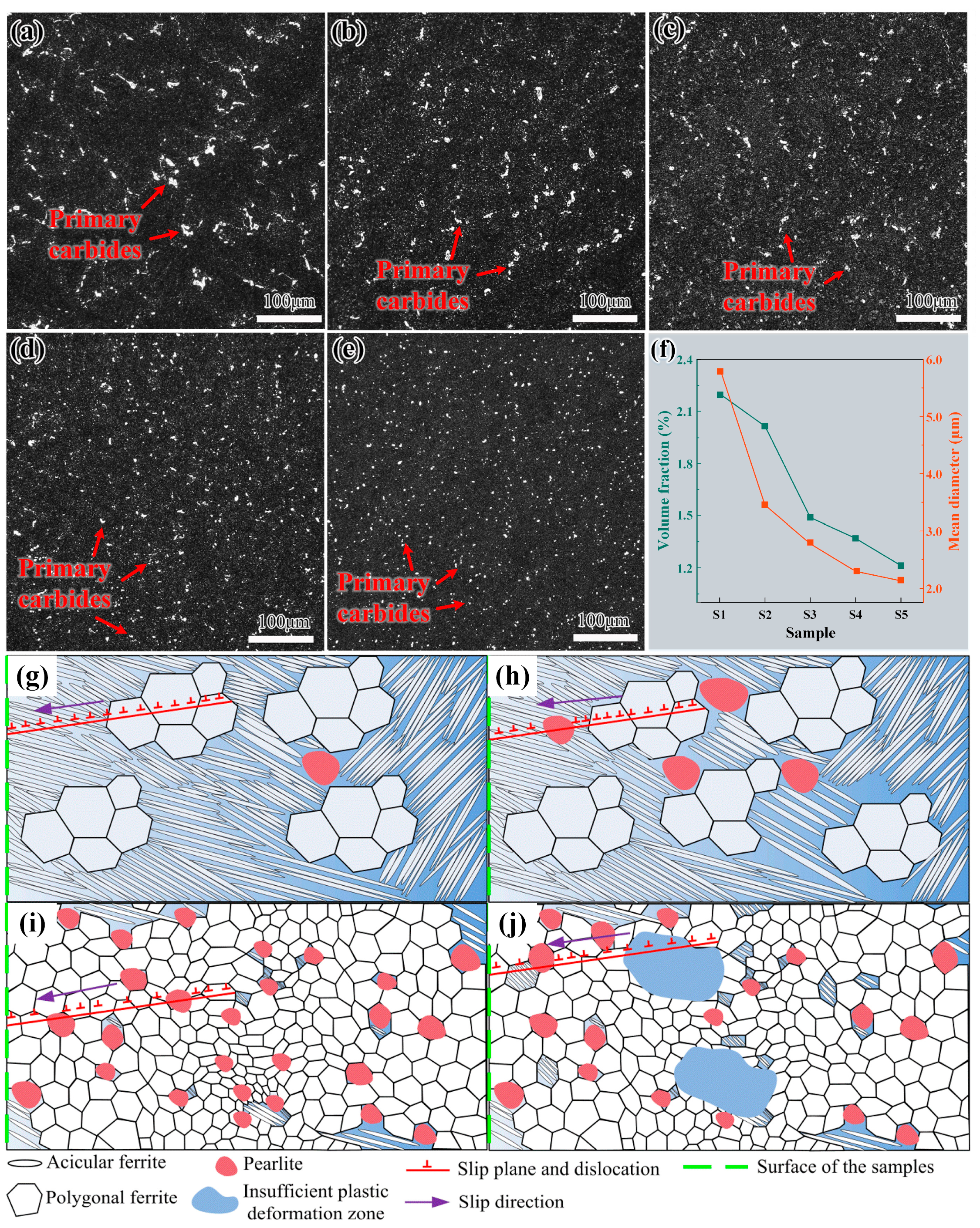
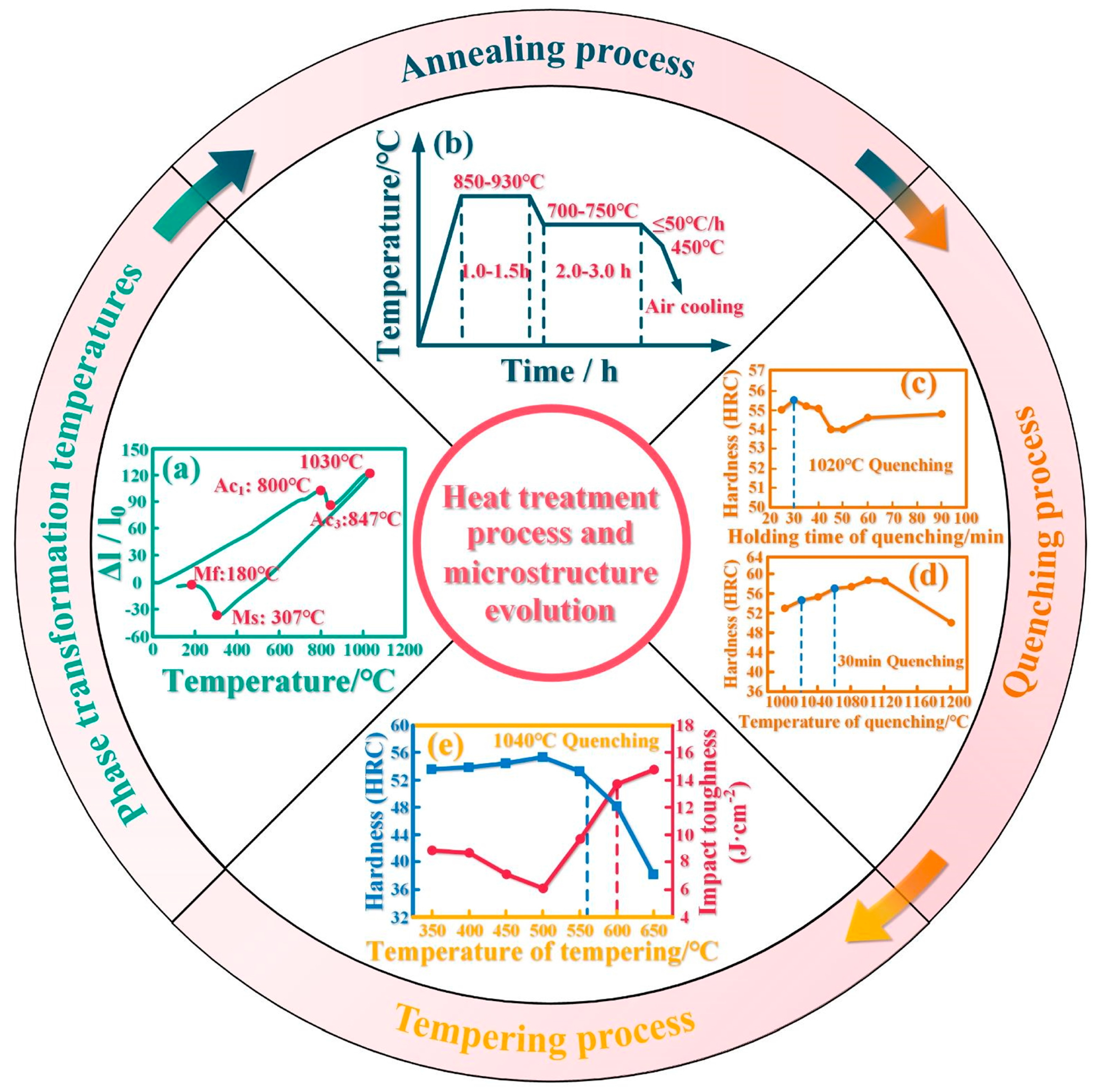
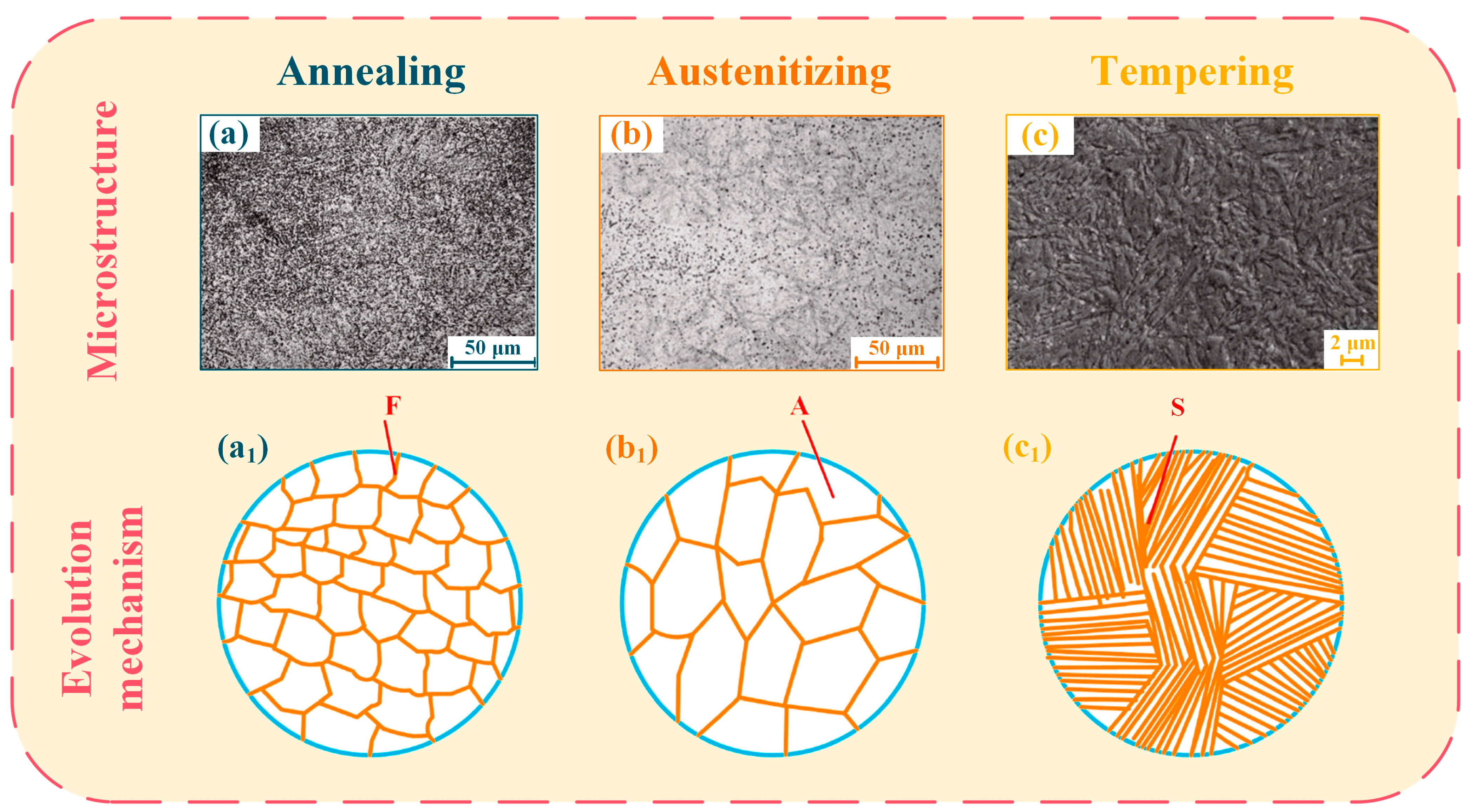
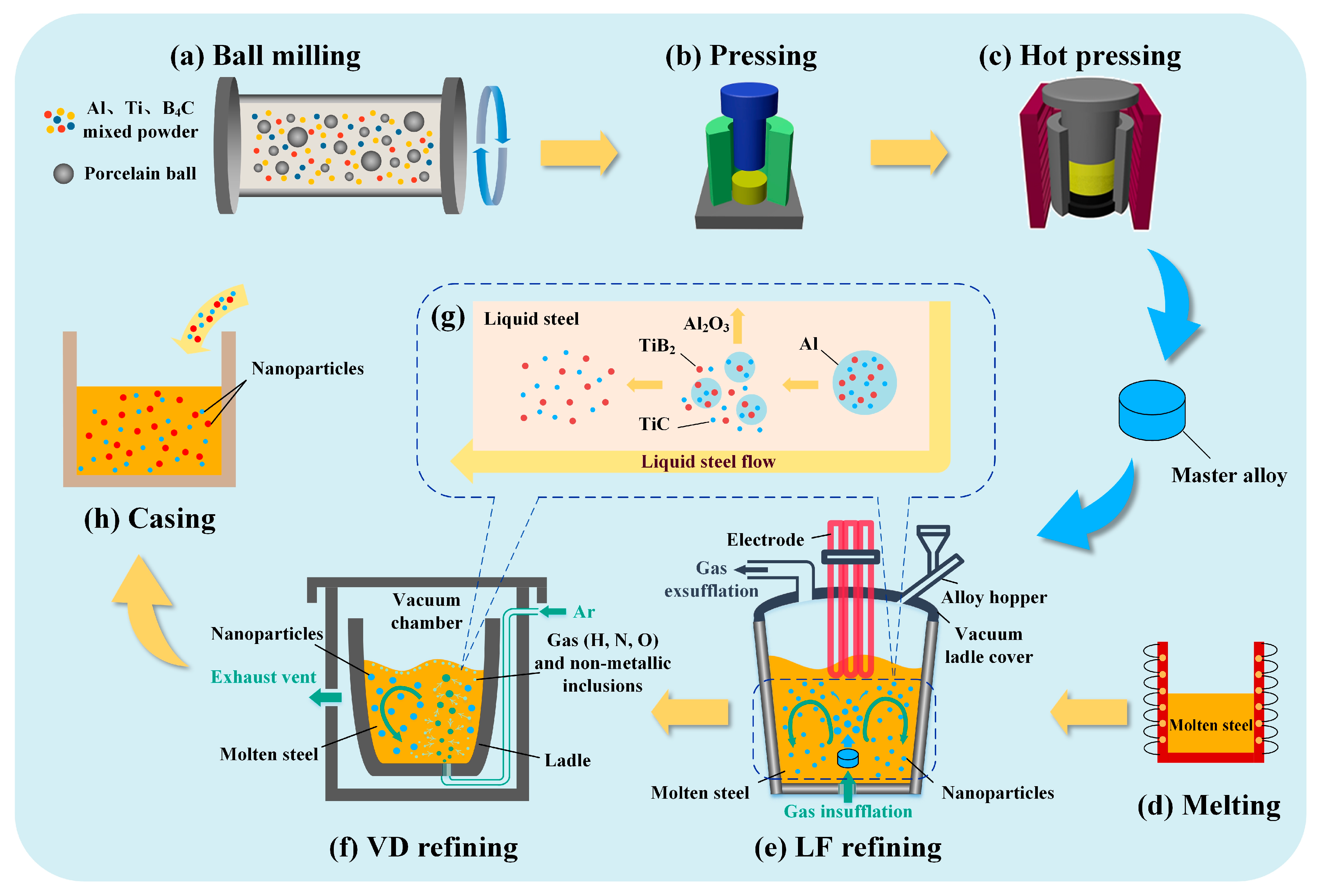
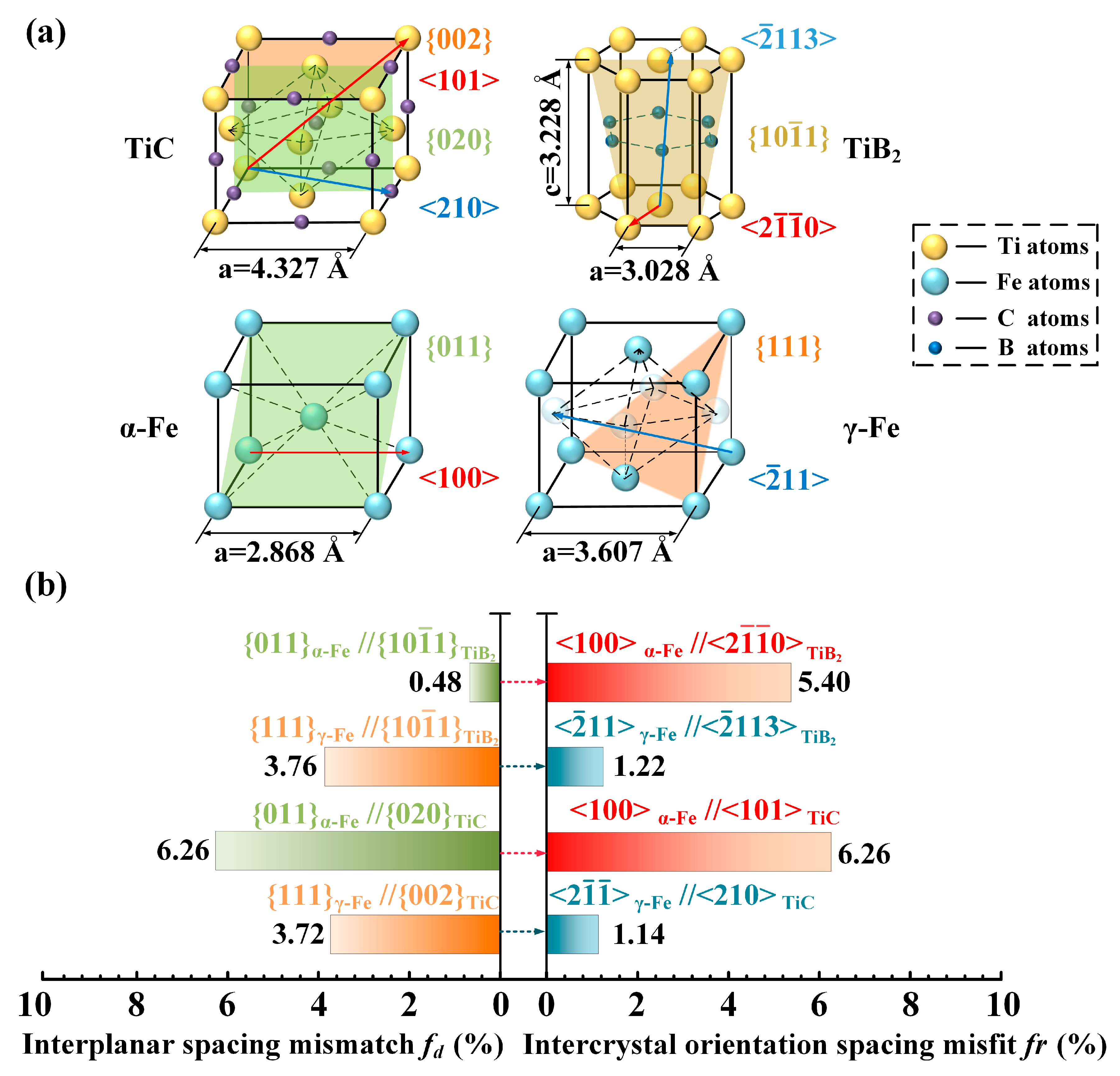
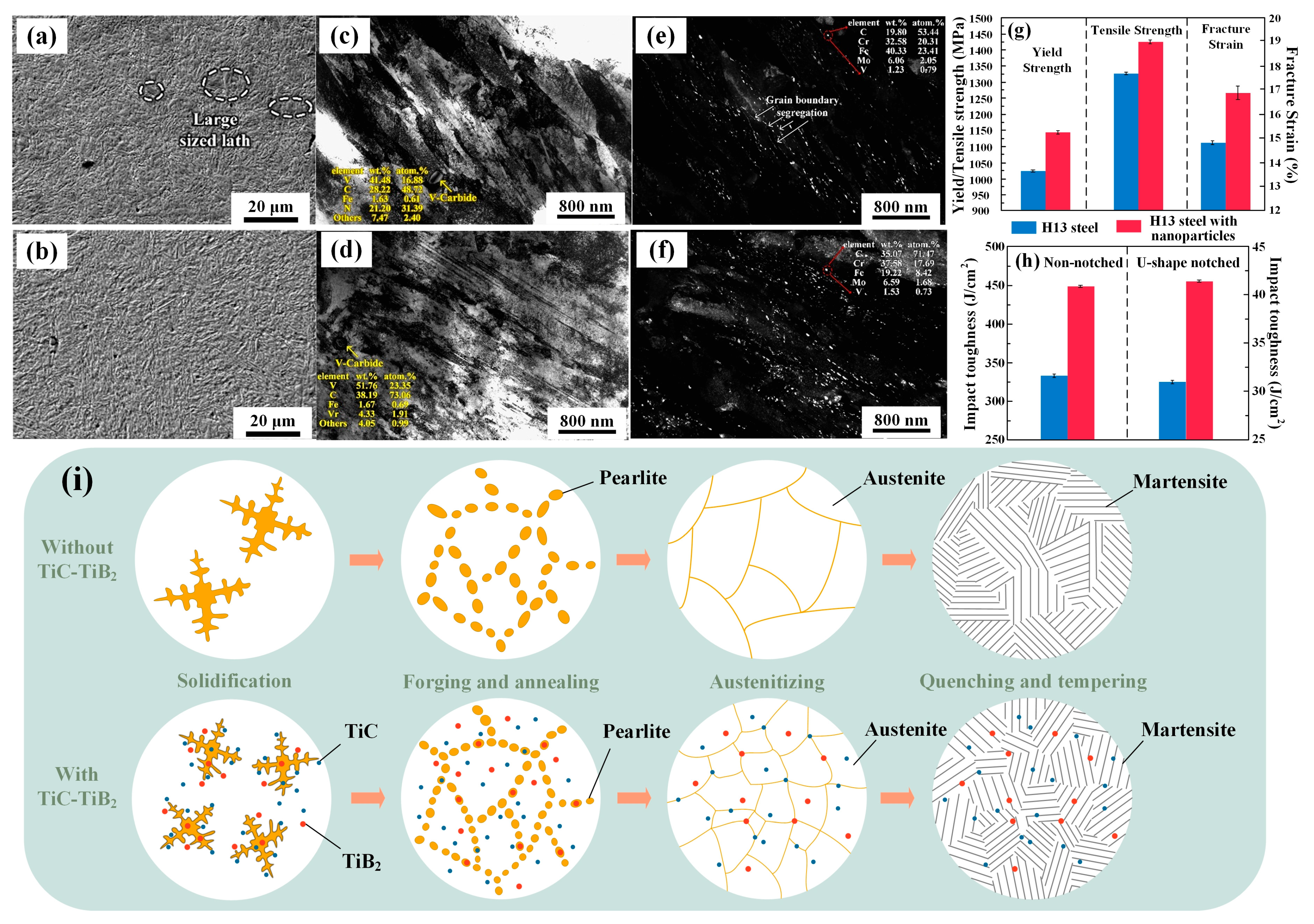
| GB | ASTM/AISI | JIS | DIN | ISO |
|---|---|---|---|---|
| 5CrMnMo | - | SKT3 | - | - |
| 5CrNiMo | L6 | - | 1.2714 | - |
| 5CrNi2MoV | - | SKT4 | - | 55NiCrMoV7 |
| - | 6G | SKT5 | 1.2323 | - |
| 4CrNi4Mo | - | SKT6 | - | 45NiCrMo1-6 |
| 4CrW2Si | S1 | SKS41 | 1.2542 | 45WCrV2 |
| 4Cr3Mo3SiV | H10 | SKD7 | 1.2365 | X32CrMoV3-3 |
| 4Cr5MoSiV | H11 | SKD6 | 1.2343 | X37CrMoV5-1 |
| 4Cr5MoSiV1 | H13 | SKD61 | 1.2344 | X40CrMoV5-1 |
| 3Cr2W8V | H21 | SKD5 | 1.2581 | X30WCrV9-3 |
| Phase | Crystal Structure | Lattice Parameter/nm | C.P. Plane | ƒd | C.P. Orientation | ƒr | Ref. |
|---|---|---|---|---|---|---|---|
| γ-Fe | FCC | a = 0.3618 | {111} | 3.72% | <> | 1.14% | [142] |
| TiC | FCC | a = 0.4327 | {002} | <210> | |||
| α-Fe | BCC | a = 0.2866 | {011} | 6.26% | <100> | 6.26% | [143] |
| TiC | FCC | a = 0.4327 | {020} | <101> | |||
| γ-Fe | FCC | a = 0.3618 | {111} | 3.76% | <11> | 1.22% | [109] |
| TiB2 | HCP | a = 0.3028 | {1} | <113> | |||
| c = 0.3228 | |||||||
| α-Fe | BCC | a = 0.2866 | {011} | 0.48% | <100> | 5.40% | [109] |
| TiB2 | HCP | a = 0.3028 | {1} | <0> | |||
| c = 0.3228 |
Disclaimer/Publisher’s Note: The statements, opinions and data contained in all publications are solely those of the individual author(s) and contributor(s) and not of MDPI and/or the editor(s). MDPI and/or the editor(s) disclaim responsibility for any injury to people or property resulting from any ideas, methods, instructions or products referred to in the content. |
© 2023 by the authors. Licensee MDPI, Basel, Switzerland. This article is an open access article distributed under the terms and conditions of the Creative Commons Attribution (CC BY) license (https://creativecommons.org/licenses/by/4.0/).
Share and Cite
Bao, Z.-J.; Yang, H.-Y.; Dong, B.-X.; Chang, F.; Li, C.-D.; Jiang, Y.; Chen, L.-Y.; Shu, S.-L.; Jiang, Q.-C.; Qiu, F. Development Trend in Composition Optimization, Microstructure Manipulation, and Strengthening Methods of Die Steels under Lightweight and Integrated Die Casting. Materials 2023, 16, 6235. https://doi.org/10.3390/ma16186235
Bao Z-J, Yang H-Y, Dong B-X, Chang F, Li C-D, Jiang Y, Chen L-Y, Shu S-L, Jiang Q-C, Qiu F. Development Trend in Composition Optimization, Microstructure Manipulation, and Strengthening Methods of Die Steels under Lightweight and Integrated Die Casting. Materials. 2023; 16(18):6235. https://doi.org/10.3390/ma16186235
Chicago/Turabian StyleBao, Ze-Ju, Hong-Yu Yang, Bai-Xin Dong, Fang Chang, Chuan-De Li, Ying Jiang, Liang-Yu Chen, Shi-Li Shu, Qi-Chuan Jiang, and Feng Qiu. 2023. "Development Trend in Composition Optimization, Microstructure Manipulation, and Strengthening Methods of Die Steels under Lightweight and Integrated Die Casting" Materials 16, no. 18: 6235. https://doi.org/10.3390/ma16186235
APA StyleBao, Z.-J., Yang, H.-Y., Dong, B.-X., Chang, F., Li, C.-D., Jiang, Y., Chen, L.-Y., Shu, S.-L., Jiang, Q.-C., & Qiu, F. (2023). Development Trend in Composition Optimization, Microstructure Manipulation, and Strengthening Methods of Die Steels under Lightweight and Integrated Die Casting. Materials, 16(18), 6235. https://doi.org/10.3390/ma16186235









